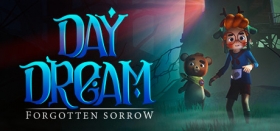
Daydream: Forgotten Sorrow Review
Daydream: Forgotten Sorrow is the debut puzzle platformer from indie studio Frozen Lines, where you’ll guide a small child, Griffin, and his loyal teddy bear, Birly, through a surreal, dreamlike world complete with floating castles, vibrant forests, and industrial workshops. Akin to popular titles like DARQ and Little Nightmares, this also attempts to be a dark adventure, as our young protagonist’s regrets and trauma come alive in the form of mysterious horrors, often contrasting with the game’s many whimsical environments.
The visual presentation of Daydream is excellent. It’s very Pixar-esque in its art style, from environmental backdrops to character designs, which makes sense since Frozen Lines referred to those beloved animated movies as a source of inspiration. Each level delivers a wide variety of visual elements that evoke a sense of wide-eyed, child-like wonder, such as a majestic blue whale, spiralling towers, and a flying bicycle. Even the darker aesthetics and enemies are eye-catching, especially the creepy skeletal hand that frequently chases Griffin and Birly throughout the game. To top it off, it’s all complemented by a soothing yet melancholic soundtrack; a perfect fit for this game’s atmosphere.

A fine coat of paint can’t fix a flawed foundation, though. Daydream’s strong art and sound design are beautiful pieces that can’t mask the game’s tonal struggles, as it won’t commit to whimsy or gloom, and its attempt to balance the two is a bit disjointed. The game’s opening moments, for instance, lean heavily into horror, with Griffin and Birly running away from the aforementioned skeletal hand only to find themselves in an eerie, dilapidated house, priming me for a spooky experience to come. However, this initial chase sequence is the peak of Daydream’s scary offerings; it seems to know it, too, sending you running in the same manner whenever a burst of action is needed. It loses its spooky lustre quickly, even when it is trying to terrify you. Going forward, colourful, fantastical settings fill most of your playthrough — a mismatch to the established tone, and while the contrast could have been great if it were done well, the lightheartedness is overpowering while the darker elements are severely lacking in their execution.
Daydream’s storytelling heavily relies on environmental pieces and wordless cutscenes to unfold its vague narrative. I’m all for a silent, up-to-interpretation type of tale, but each of the story beats feel like ripped-out chapters from separate books in that they don’t really go together nor do they feel like a natural lead-up to either of the two endings you can discover. While you can uncover hidden collectibles throughout the chapters, adding small snippets of context that you can read in your Dream Story, they can go easily unnoticed, which doesn’t help the narrative at all. You can replay levels to find them, but, unfortunately, the gameplay itself might make you think twice about doing that.

Finicky controls are the main source of frustration when it comes to solving puzzles or even just moving around Daydream’s 2.5D levels. Perhaps the floaty jumping and slow movement were meant to be immersive in this dreamlike world, but it only serves to cause needless deaths as you regularly short jumps or miss the landing by a lot due to poor depth perception. I could hardly control Griffin properly, let alone his companions — Birly and, later on, Mira. Not only do they join you on your adventure, but you can also command them to help you overcome obstacles… when the input actually works. Most of the time, the command button was unresponsive, and I had to spam it until it registered, which was especially frustrating during puzzles where your timing had to be precise.
Death by clunky controls is never fun, and Daydream makes it especially tedious by slowly fading into the level from a black screen. You’ll see Griffin sitting, knees pulled to his chest, and it takes him much too long to stand and yield back the controls to the player. There are some other odd issues as well, such as Griffin getting stuck on some surfaces, causing me to restart at a recent checkpoint, or even randomly dropping items before I can place them where they need to go, which is just annoying. Birly and Mira weren’t safe from bugs either, as I encountered problems with their command prompts occasionally not appearing at all.

On a positive note, I appreciated that the puzzles offered a wide variety of visuals. Mechanics, on the other hand, were hit-or-miss in terms of being interesting, but some did stand out. From figuring out how to smelt a metal gear to realigning the electrical current of lightbulbs, there are glimpses of the engaging experience Daydream could have offered. There’s also quite a bit of creativity injected into some levels, such as flying your bike through caves and around geysers or jumping into an old painting only to have it start burning into ash; even these cool sections, though, are soured by the poor controls, making them hard to enjoy despite their potential.
I really wanted to love Daydream: Forgotten Sorrow. On the tin, it promises everything I’d want from a new title in this genre, such as a compelling narrative along with mind-bending puzzles, but the follow-through is less than stellar. Unfortunately, the exploration of Griffin’s inner fears hovers at the surface all throughout, never going as deep as it could have to leave a lasting impression. The platforming should have been the shining star, but instead, it’s the weakest component, plagued by frustrating controls and tedious deaths. While the art design and soundscapes are beautiful, there are better offerings in the genre when it comes to gameplay, making this one hard to recommend.
Daydream: Forgotten Sorrow (Reviewed on Windows)
Minor enjoyable interactions, but on the whole is underwhelming.
Daydream: Forgotten Sorrow is an underwhelming puzzle platformer. The eye-catching, whimsical environments simply aren’t enough to salvage the poor storytelling and frustrating controls.









COMMENTS